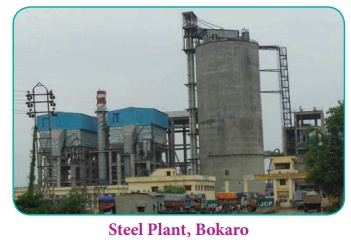Development of Industry
India was committed to the idea of promoting rapid industrial growth for economic development. Development can be achieved through several pathways. In a country like India with a large population where many raw materials were grown or were available, processing industries which were more labour-intensive would have also led to industrial growth. Alternatively, the Gandhian model stressed a model of growth with village and cottage industries as the ideal way to produce consumer goods, which would eliminate rural poverty and unemployment.
But the government adopted the Nehruvian model of focusing on large scale, heavy industry to promote wide-ranging industrial development. In keeping with the basic principle of a “socialistic society”, the state would play a major role in developing the industrial sector through setting up units wholly owned by the state. The emphasis on heavy industry was to promote the production of steel and intermediate products like machines, chemicals and fertilizers for the developing industries. The social purpose that would be achieved by this model of development was to restrict private capital which was considered to be exploitative and excessively profit-oriented, which benefited a small class of capitalists
(a) Industrial Policy
A series of Industrial Policy statements were adopted to promote these objectives. The first policy statement was made in 1948. It classified industries into four categories:
1. Strategic industries which would be state monopolies (atomic energy, railways, arms and ammunition);
2. 18 industries of national importance under government control (heavy machinery, fertilizer, heavy chemicals, defence equipment, etc.);
3. Industries in both the public and private sectors;
4. Industries in the private sector.
The most definitive policy statement was the Industrial Policy Resolution of 1956 which classified industries into three categories: Schedule A industries were under the monopoly of the state; Schedule B industries, the state could start new units but the private sector could also set up or expand their units; Schedule C were the remaining industries.
The Industrial Development and Regulation Act of 1951 was an important instrument for controlling the private sector. This Act stipulated that no new industrial units could be set up, nor the capacity of existing units expanded without a licence or permit from the government.
The Policy Statement of 1973 encouraged large industrial houses to start operations in rural and backward areas to reduce regional imbalances in development. The Policy Statement of 1977 was framed by the short-lived Janata government which was aimed at promoting rural, village and small scale industries.
The Policy Statement of 1980 was announced by the Congress government which also aimed at promoting balanced growth. Otherwise all these statements continued the ideology of a strong public sector owned by the state and control over the private sector and especially the large business houses.
There were also other interventions which intruded into the market economy. For instance, inputs produced in the private sector like cement were rationed, and permits had to be obtained even for private construction of houses. The manufacture of consumer goods was severely restricted under the licensing policy. This was partly an expression of the ideology of reducing inequalities in consumption between the affluent and weaker sections of society. But it was also a way to ensure that scarce resources like steel, cement etc. would be used in strategic industries for the long-term development of the economy.
Many important industries and services were nationalised. These included coal mines, petroleum companies, banking and insurance services. Private entrants have been allowed into some of these activities only in recent years.
(b) Public Sector
There were only five public sector enterprises in India in 1951. By 2012, this number had increased to 225. The capital investment increased from ₹ 29 crores in 1951 to 7.3 lakh crores in 2012. The setting up of public sector enterprises in heavy industry was again dictated by two considerations. First, at the ideological level, the government was committed to a socialistic pattern of development which involved a high degree of state control over the economy. But at a more practical level, the government had to take over the responsibility for the establishment of heavy industrial units which required a very high level of investment. These were known as “long gestation” projects, that is, it would take many years before such units would be able to start production.

In the 1950s, the private sector did not have the resources or the willingness to enter into such investment. Steel plants in Bhilai (Chhattisgarh), Rourkela (Odisha), Durgapur (West Bengal), Bokaro (Jharkhand), engineering plants like Bharat Heavy Electricals (BHEL) and Hindustan Machine Tools were all set up in the 1950s in collaboration with Britain, Germany and Russia which provided the technical support.

Units which did not have to be located near raw material sources were set up in backward areas to reduce regional disparities in industrial and economic development. BHEL was first set up in Bhopal, and later in Tiruchirappalli, Hyderabad and Haridwar. Steel plants were set up in the relatively backward belt of Orissa, Bihar and West Bengal. Public sector enterprises also contributed to the national exchequer because their profits accrued in part to the central government. Thus the growth of the public sector served many economic and social purposes, in addition to creating industrial capacity in the country.
(C) Crisis in Public Sector Industrial Units
By 1991 it was clear that public sector enterprises were facing severe problems. While on the whole they were showing a profit, nearly half of the profit was contributed by the petroleum units. Many were making continuous losses. Part of the problem lay in the expansion of the public sector into non-strategic areas like tourism, hotels, consumer goods (for instance, in the 1970s, television sets were produced only by public sector companies) and so on.
There were many factors which contributed to the poor performance of public sector enterprises. Decisions on location were made for political rather than efficiency considerations. Delays in construction resulted in cost overrun, so that the units were overcapitalized. Administrative prices were not always economical and did not make sense when the intermediate goods produced in the public sector were used as inputs in the private sector. Public sector units were also overstaffed, though the technology of heavy industries did not require so many workers. This increased the operating cost of the units. Bureaucrats were entrusted with the management of public enterprises, leading to inefficiency in management. Recognising all these problems, the government began a programme of disinvestment of the loss-making and non-strategic units in 1991.
In spite of all the shortcomings, the strategy of industrialisation by concentrating on building up long-term industrial capacity through the establishment of heavy industries has been successful in making India into a modern, industrial economy.
(d) Liberalisation: Industrial Policy Statement 1991
Finally in 1991 the Indian government announced a shift in its industrial policy to remove controls and licences, moving to a liberalised economy permitting a much larger role to the private sector. The share of the public sector was to be reduced through a policy of disinvestment and closure of sick units. This created a sea change in the economic outlook of the country, particularly from the point of view of the consumers. It is not merely that the aspirations of the growing middle class for a better standard of living in terms of availability of goods and services have been met. Even the lower income families could now buy such goods.
On the positive side, liberalisation has certainly made India a more attractive destination for foreign investment. State governments are keen to advertise that they are relaxing restrictions to improve the ease of doing business in their state. All this has created a general air of prosperity which is reflected in the growth statistics of the economy as a whole.
On the negative side, liberalisation and globalisation have resulted in a significant increase in income disparities between the top income groups and the lower income groups. The removal of ceilings on corporate salaries has widened the disparities between the salaried class of corporate executives and wage earners. The formal sector has very limited potential for additional employment and most of the new employment is generated in the informal sector, and disparities have also increased across these two sectors.
However, neither the advocates of a free economy nor leftist economists are happy with the level of liberalisation. The former want more free play of market forces to eradicate imbalances and checks to progress which are still in place. The leftists are unhappy that the state has abdicated its responsibility of ensuring and promoting social justice and welfare by allowing free play to private capitalists to exploit the economy.














